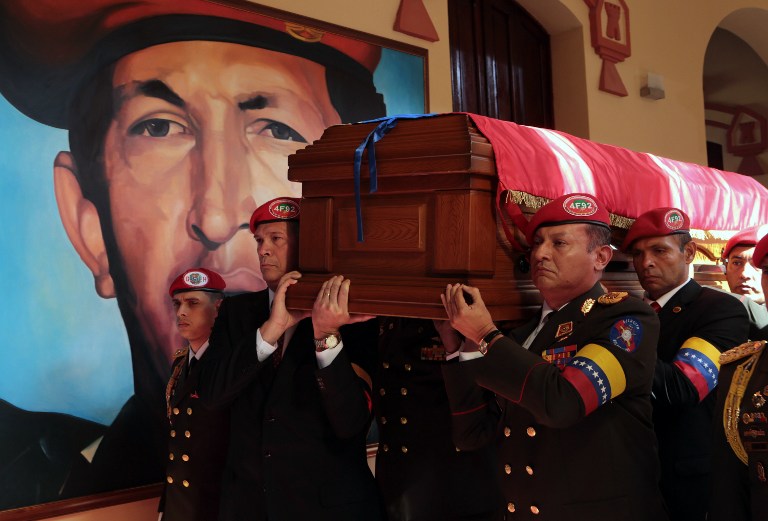SUMMARY
This is AI generated summarization, which may have errors. For context, always refer to the full article.

CARACAS, Venezuela – Thousands of emotional supporters waited and wept Saturday, March 16, after making a pilgrimage to the new tomb of former president Hugo Chavez, the face and leader of Latin America’s left for over a decade.
More than 10 days after his death from cancer, the remains of Chavez who was 58, are now entombed in a marble sarcophagus at the Mountain Barracks in Caracas.
“This is a time of grieving. My heart just shriveled up when I saw him in that room. But then I remember him with happiness for all that he has given me,” said Lino Mejia, 72, who came from Lara state in the west to bid farewell to Chavez, whose oil-funded socialist programs included heavy spending on housing and health care.
At the center of an imposing hall with towering columns, yellow brickwork and tile floors, Mejia and masses of other Chavez supporters had no choice but to settle for glimpsing at the monument — flanked by soldiers — from afar.
At the entrance to the area, visitors are asked not to approach the sarcophagus or take pictures.
Chavez was laid to rest at a military museum on Friday, March 15, after an emotional final journey through the streets of Caracas watched by hundreds of thousands.
After more than a week lying in state, Chavez’s body was driven through the Venezuelan capital in a hearse, allowing his compatriots to say goodbye to the man who ruled the South American OPEC member atop the world’s largest proven oil reserves, for 14 years.
Friends and family joined government and army officials in surrounding the coffin as it arrived at Chavez’s final resting place — the hilltop former army barracks-turned-museum where he plotted his failed 1992 coup.
The inscription on Chavez’s tomb reads: “Hugo Chavez, Supreme Leader of the Bolivarian Revolution.” Bolivar was the local independence-era hero whose ideas Chavez said inspired him.
The room is replete with images of Chavez, several of his slogans already carved into marble, with a massive portrait of Simon Bolivar looking on. There were pictures of Chavez with his political mentor and key ally, Fidel Castro; another with soccer icon Diego Armando Maradona; and another with British supermodel Naomi Campbell.
Guards outside the barracks fire a single shot each afternoon at 16:25 local time (2055 GMT): the exact time Chavez died. Not surprisingly for a government that modeled much of its revolutionary “infrastructure” on Communist Cuba’s instititutions, the barracks with Chavez’s tomb inside is now being called the “Museum of the Revolution.”
Late on Friday officials ruled out embalming Chavez, whose death the government announced March 5, and leaving his body on permanent public display in a similar fashion as Vladimir Lenin, the leader of the 1917 Bolshevik revolution in Russia, whose embalmed body rests to this day in a glass case in a mausoleum on Moscow’s Red Square. – Rappler.com
Add a comment
How does this make you feel?
There are no comments yet. Add your comment to start the conversation.